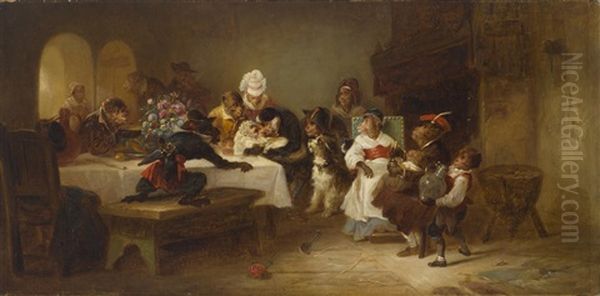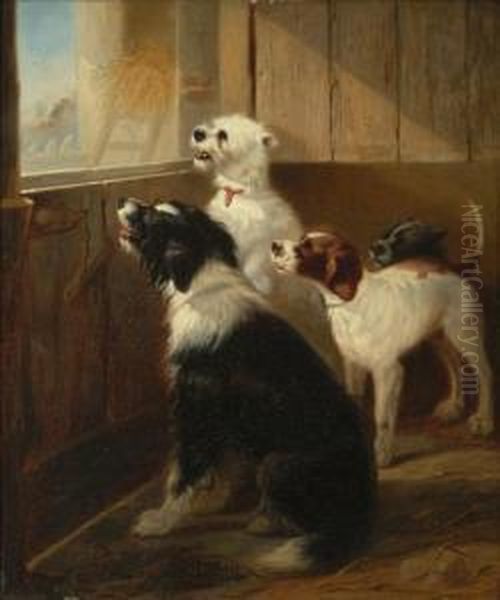Introduction: A Belgian Artist in Paris

Zacharias Noterman, also sometimes documented as Zacharie Noterman, stands as a distinctive figure within the landscape of 19th-century European art. Born in Ghent, Belgium, in 1824 (though some earlier sources occasionally cited 1820), and passing away in Paris in 1890, Noterman carved a unique niche for himself primarily as a painter and etcher of animals. He is particularly celebrated for his humorous and meticulously rendered "singeries" – scenes depicting monkeys dressed in human attire and engaging in human activities – a genre he revitalized with considerable skill and wit. His work, however, extended beyond anthropomorphic satire to include sensitive and detailed portrayals of dogs and cats, showcasing his keen observational skills and affection for his subjects. Trained initially within his artistic family and later at the prestigious Royal Academy of Fine Arts in Antwerp, Noterman eventually sought the vibrant artistic milieu of Paris, where he spent a significant portion of his career and achieved notable recognition.
Early Life and Artistic Formation in Belgium
Zacharias Noterman's journey into the world of art began in Ghent, a city with a rich artistic heritage. He was born into a family where creative pursuits were valued; his father, Jean Noterman, worked as a painter specializing in decorative ceilings and also practiced as a mason. His mother was Marie-Catherine Haelterman. This environment likely fostered an early appreciation for craftsmanship and visual expression. Crucially, Zacharias received his initial artistic instruction from his older brother, Emmanuel Noterman (1808-1863), who was already establishing himself as an artist, also known for animal paintings and genre scenes. This familial mentorship provided a foundational grounding in technique and perhaps steered Zacharias towards the animal subjects that would define his career.

Seeking more formal training, Noterman enrolled at the Royal Academy of Fine Arts in Antwerp. Antwerp, historically a major European art center, offered rigorous academic instruction. Studying at the Academy would have exposed him to classical principles of drawing, composition, and painting, honing the technical skills evident in the detailed finish of his later works. During this period, he reportedly lived and perhaps collaborated with his brother Emmanuel in Antwerp, further immersing himself in the practice and business of art. This Belgian phase laid the essential groundwork for his technical proficiency and thematic interests before his eventual move to the continent's artistic epicenter.
The Lure of Paris: Career Development
Like many ambitious artists of his time, Zacharias Noterman recognized the magnetic pull of Paris. In the mid-19th century, Paris was unequivocally the capital of the Western art world, boasting a concentration of artists, dealers, critics, and, most importantly, the official Salon – the primary venue for exhibition and career advancement. After his formative years and initial professional experiences in Antwerp, Noterman made the pivotal decision to relocate to Paris. This move signified a desire to engage with a larger, more competitive, and potentially more rewarding art market.
Establishing himself in Paris allowed Noterman to develop his signature style further and present his work to a wider, more international audience. The city offered endless inspiration, from its bustling street life to its cultural institutions and menageries, which might have provided opportunities to study animal anatomy and behavior firsthand. While details of his specific social circles in Paris are scarce, his regular participation in the Paris Salon indicates that he successfully navigated the city's complex art scene. He remained in Paris for the remainder of his life, continuing to paint and exhibit, ultimately passing away there in 1890, having cemented his reputation within his chosen specialty.
Artistic Style: The Singerie Specialist
Zacharias Noterman's most distinctive contribution to 19th-century art lies in his mastery of the "singerie." This French term translates literally to "monkey trick" and refers to a genre of art depicting monkeys aping human behavior, often dressed in contemporary or historical costumes. While the genre had precedents, notably flourishing in the Rococo period with artists like Christophe Huet and finding earlier expression in the works of Flemish masters such as David Teniers the Younger, Noterman brought his own 19th-century sensibility to it. His singerie paintings are characterized by meticulous detail, a rich color palette typical of academic painting, and, crucially, a pervasive sense of humor and gentle satire.

Noterman's monkeys are often shown engaged in activities common to human social life: playing cards, drinking in taverns, smoking pipes, playing musical instruments, or even participating in mock ceremonies. Titles like Monkey Wedding and Monkey Baptism (often painted as a pair) or Assemblée de singes dans une taverne (Gathering of Monkeys in a Tavern) exemplify this approach. These scenes function on multiple levels. They are undoubtedly amusing, capitalizing on the inherent comedy of seeing animals mimic human actions. However, they also serve as subtle social commentary, using the monkeys as allegorical figures to poke fun at human vanities, vices, and rituals. The detailed rendering of costumes, interiors, and accessories grounds these fantastical scenes in a relatable reality, enhancing both the humor and the underlying critique. Noterman's skill lay in balancing the anthropomorphism with believable animal anatomy, creating scenes that were both whimsical and technically accomplished. His work in this vein found a ready audience appreciative of its wit and craftsmanship. Other artists like Alexandre-Gabriel Decamps also occasionally depicted monkeys, but Noterman made it a central pillar of his oeuvre.
Beyond Monkeys: Canine and Feline Portraits
While the singerie paintings represent Noterman's most famous output, he was also a highly capable painter of domestic animals, particularly dogs and cats. These works often display a different facet of his artistic personality, characterized by careful observation, sensitivity, and a clear affection for the animals themselves. Unlike the satirical intent of the singeries, his paintings of dogs and cats focus on capturing their individual character, textures of fur, and natural postures. Works like Dogs Resting showcase his ability to render different breeds with accuracy and to compose tranquil, intimate scenes.
These animal portraits align Noterman with a strong tradition of animal painting (animalier art) that was popular throughout the 19th century. He shared this field with celebrated contemporaries across Europe, such as the British painter Sir Edwin Landseer, renowned for his dramatic and often anthropomorphized depictions of animals, particularly stags and dogs, and the French painter Rosa Bonheur, famous for her large-scale, realistic portrayals of horses and farm animals. While Noterman's animal works might be less monumental than Bonheur's or less overtly narrative than Landseer's, they possess a quiet charm and technical solidity. His painting Jeune garçon nourrissant des chiens (Young Boy Feeding Dogs) combines his skill in animal depiction with a genre element, creating a heartwarming scene. His ability extended to depicting groups, as seen in works sometimes titled Dog Group or Cat Group, demonstrating compositional skill alongside anatomical accuracy. These works appealed to the widespread affection for pets and the appreciation for realistic representation prevalent in the era. Belgian contemporaries like Joseph Stevens also gained recognition for their depictions of dogs, often in urban settings, providing a local context for Noterman's interest in these subjects.
Other Subjects and Techniques
Beyond his primary focus on monkeys, dogs, and cats, Noterman occasionally explored other related themes. Some sources suggest an interest in circus scenes, which would naturally align with his skill in depicting animals and potentially offer further avenues for observing animal-human interactions and costumed performance, echoing elements of his singerie work. The depiction of bears, as evidenced by a work titled Bear Group in a Grotto, shows a willingness to tackle larger, wilder animals, again demonstrating his versatility within the animalier genre.
Furthermore, Noterman was not solely a painter; he was also proficient as an etcher or engraver. This aspect of his practice allowed him to reproduce his popular compositions or create original works in print media. Printmaking could reach a wider audience than unique paintings and was a common way for artists to disseminate their images. His engravings likely mirrored the subjects of his paintings – humorous monkey scenes and detailed animal studies. This dual practice as both painter and printmaker was not uncommon and highlights his technical versatility and engagement with different modes of artistic production available in the 19th century. His detailed style lent itself well to the precise lines achievable through etching.
Exhibitions and Recognition: The Paris Salon
For an artist working in Paris during the 19th century, participation in the official Salon de peinture et de sculpture was paramount for establishing and maintaining a reputation. The Salon, organized annually or biennially, was the principal state-sponsored art exhibition, attracting vast crowds and critical attention. Acceptance into the Salon conferred legitimacy and provided crucial exposure to potential patrons, dealers, and the public. Zacharias Noterman regularly submitted his works to the Paris Salon and succeeded in having them exhibited on numerous occasions.
His participation demonstrates that his work, despite its often humorous or specialized nature, met the technical standards and appealed to the tastes of the Salon juries and audiences. Exhibiting alongside the giants of academic art, such as Jean-Léon Gérôme, William-Adolphe Bouguereau, or Alexandre Cabanel, as well as numerous other genre and animal painters, placed Noterman firmly within the mainstream art world of his time. While perhaps not reaching the highest echelons of fame occupied by historical or portrait painters, his consistent presence at the Salon indicates a successful professional career and recognition from his peers and the art establishment. His singerie and animal paintings offered a lighter, often amusing counterpoint to the more serious historical, mythological, or religious subjects that dominated the Salon walls, carving out a popular and respected niche.
Artistic Context: Noterman and His Contemporaries
Zacharias Noterman's career unfolded during a dynamic period in European art history. While he wasn't directly associated with the revolutionary avant-garde movements like Impressionism that emerged during his lifetime, his work exists within the broader context of 19th-century realism, academicism, and genre painting. His meticulous technique and detailed finish align with academic standards prevalent at the Paris Salon. His subject matter – animals and humorous genre scenes – catered to a bourgeois market that appreciated narrative, sentiment, and skillful representation.
In Belgium, his brother Emmanuel Noterman pursued similar themes. Other Belgian artists like Joseph Stevens and, to some extent, Alfred Stevens (though more known for elegant Parisian scenes), engaged with realism and genre subjects. The influence of historical painters like Baron Henri Leys, a major figure in Antwerp during Noterman's training, underscored the importance of technical skill and historical detail in Belgian art.
Internationally, Noterman's singerie work connects him to a lineage including David Teniers the Younger and Christophe Huet, while his animal painting places him alongside contemporaries like Edwin Landseer, Rosa Bonheur, and French Barbizon painters who depicted animals, such as Constant Troyon. His detailed genre approach shares some affinities with the meticulousness of artists like Jean-Louis-Ernest Meissonier, although Noterman's focus remained narrower and more humorous. By exhibiting at the Paris Salon, he shared a platform with the era's most famous academic painters, contributing his unique specialty to the diverse tapestry of official art. His work offers a fascinating glimpse into the specific tastes and popular subgenres that thrived alongside the grand narratives of academic painting and the burgeoning experiments of modernism.
Legacy and Collections
Zacharias Noterman left behind a body of work that continues to charm and intrigue viewers today. His skillful blend of realistic animal depiction with humorous anthropomorphism secured him a distinct place in the history of 19th-century genre painting. While not a radical innovator in the sense of the Impressionists or Post-Impressionists, he excelled within his chosen specialty, demonstrating considerable technical ability and a keen sense of observation, both of animal behavior and human folly. His singeries, in particular, remain popular examples of the genre, appreciated for their wit, detail, and imaginative scenarios.
His legacy is preserved not only through the continued appreciation of his works in the art market but also through their inclusion in public collections. Museums across Europe and North America hold examples of his paintings and potentially his prints. The provided information notes collections such as the Musée de Dunkerque, the Musée d'art et d'histoire de Cognac, the Petit Palais in Paris, the Musée d'Art Ancien (likely the Royal Museum of Fine Arts Antwerp), the Brussels City Museum (Musée d'Art de la Ville de Bruxelles), the Montreal Museum of Fine Arts, and the National Gallery of Canada in Ottawa. The presence of his work in these institutions ensures its accessibility for study and enjoyment by future generations, cementing his contribution to the rich and varied artistic production of the 19th century.
Conclusion: A Unique Voice in 19th-Century Art
Zacharias Noterman navigated the 19th-century art world with skill and a unique vision. From his early training in Ghent and Antwerp under the guidance of his brother and the Royal Academy, to his successful career centered in Paris, he developed a distinctive artistic identity. He excelled in the specialized genre of singerie, using monkeys in human guise to create humorous and subtly satirical commentaries on society, executed with meticulous academic technique. Simultaneously, he proved himself a sensitive and accomplished painter of dogs, cats, and other animals, capturing their forms and personalities with realism and affection. A regular exhibitor at the prestigious Paris Salon, Noterman achieved recognition within the established art system of his time. Though perhaps overshadowed by artists pursuing grander historical themes or pioneering modernist styles, Zacharias Noterman's work endures, valued for its craftsmanship, its wit, and its charming portrayal of the animal kingdom, often seen through the amusing lens of human behavior. He remains a notable figure in Belgian art history and the broader tradition of European animal and genre painting.